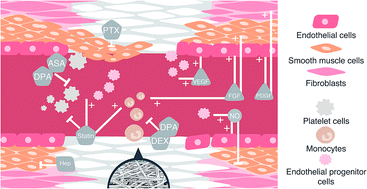Progress and perspectives in bioactive agent delivery via electrospun vascular grafts
Abstract
The review discusses the progress in the design and synthesis of bioactive agents incorporated into vascular grafts obtained by the electrospinning process. Electrospun fibers can be applied as an artificial extracellular matrix for tissue engineering and drug delivery, improving tissue regeneration and therapeutic outcomes. A large number of active substances are loaded into the fibers, such as growth factors, heparin, NO donors, statins, antibiotics or anti-inflammatory agents. There are various methods for bioactive substance incorporation including direct blending, emulsion, and coaxial electrospinning as well as covalent and non-covalent binding of the bioactive molecules to the fiber surface. The release mechanism of the drug depends on the synthesis route, active substance properties, and polymer matrix nature. The electrospun materials represent a very promising building block for the fabrication of effective vascular prosthesis in the near future.

- This article is part of the themed collection: 2017 Review articles


 Please wait while we load your content...
Please wait while we load your content...